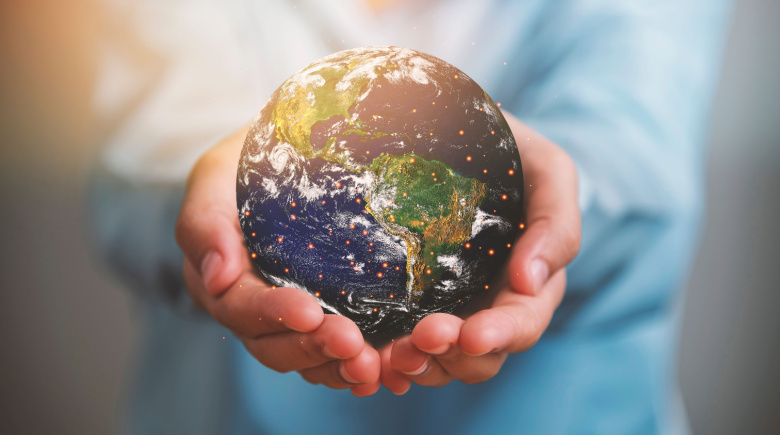The environment impacts our behavior and patterns, knowingly and unknowingly in one way or another. It is what surrounds us, living and non-living, including natural features or the natural environment such as lakes and trees, artificial features or built environment, human beings who make up your social environment and the virtual environment, which also entails platforms like the internet and media.
For instance, changes in the state of breathing air in a region will influence health, lifestyle and fashion, population, infrastructure designs, other features like rivers and soil and ultimately, the productivity of the land. Thus, such seemingly small but rather substantial environmental changes, like global warming, have tremendous adverse effects on the natural way of things.
What is Global Warming?
Global warming is the process through which heat from the sun is retained by the earth’s atmosphere, causing the temperature of the atmosphere to gradually rise over time. The greenhouse effect, a natural and supposedly beneficial mechanism, is the driving force behind global warming. In simpler terms, this process is how the planet naturally controls its temperature, by reflecting solar heat back into space.
The earth’s atmosphere is continually warmed by greenhouse gases, which include carbon dioxide, methane, and nitrogen dioxide. These gases retain solar radiation and take longer to escape from the atmosphere than regular air.
According to climate scientists, the earth’s temperature has risen by about 1.1 degrees since the 1880s and is expected to reach or surpass 1.5 degrees.
The global agenda, commonly pushed through forums like the Paris Agreement and Sustainable Development Goals, SDGs is to mitigate the rise and keep it below 2 degrees, preferably below 1.5 degrees. Achieving this would be easier if we understood what causes global warming.
What Causes Global Warming?
i. Burning Fossil Fuels
While oil leaks poison waters and soils, burnt fuels poison the air, and then the water and soils through acid rain. Once poisoned, these features retain more heat from sun rays, making the atmosphere warmer as time goes by. This, by far, is the most significant cause of pollution in all aspects of the environment.
ii. Deforestation
Deforestation contributes to global warming in a rather indirect manner. By using carbon dioxide and producing oxygen through their natural food-making process, photosynthesis, trees play a significant role in regulating the air mixture.
Air is made up of many gases, all useful in their naturally right portions. Reducing the number of trees through deforestation reduces the earth’s ability to utilize some of the gas, which creates an imbalance in the natural cycle of gases.
What are the Impacts of Global Warming?
i. Increasing Temperatures
As defined, the main adverse effects of the greenhouse effect are increasing temperatures and heat waves. This warming up is what brings about other changes in the atmosphere such as heat fluctuations that change the general climate of a region, hence the state of other features like water and soil. These increased temperatures influence people’s lifestyles and cause health problems due to changes such as weather patterns.
ii. Rising Seas and Disruption on Ecosystems
Temperature rise also causes melting glaciers and icebergs. The water is then drained into the ocean, leading to an increase in the water volume. Coastal and polar communities are the most affected by these impacts since as the water level rises, a large population is displaced.
On the other hand, polar regions experience warmer temperatures and less ice, which disrupts the ecosystem and polar animals’ way of life.
What Can We Do to Stop Global Warming?
The only way to stop global warming is to control what is causing it. Since some activities that cause global warming, such as energy production, are vital for human survival and cannot be abandoned, there is need to replace them with better, less pollutive solutions.
So, what are the possible solutions?
i. Green Energy Solutions
Green energy or renewable energy sources are the most efficient solutions to stop human dependence on fossil fuels for energy needs.
Wind and solar energy, which occur to us naturally, can be tapped and converted into more usable forms of energy. Utilizing them ensures no greenhouse gases are emitted into the atmosphere, and the energy problem is solved.
Though not the most efficient, tree products like wood and charcoal are better than fossils since they do not produce as many greenhouse gases. Other potential bio-energy solutions include bio-fuels such as bio-gas and bio-ethanol.
ii. Afforestation and Reforestation
Planting trees where they have been before or have never been, increases the tree cover and, in turn, the earth’s potential to transform carbon dioxide into oxygen, maintaining the air balance. Less carbon dioxide means less heat trapping, hence less global warming.
Additionally, trees conserve other features in the environment as well, that is, they preserve soils as they prevent erosion, and, being water catchment areas, they conserve water in the atmosphere. They also contribute to the amount of humidity in the atmosphere.
iii. Sustainable Energy-efficient Solutions
The earth is naturally designed to handle little pollution. Thus, for the essential yet pollution energy solutions that have no alternative and cannot be assumed, maximizing their efficiency can help mitigate global warming.
This could include introducing energy-efficient tools like engines and cooking methods so that maximized energy is utilized while environmental pollution is kept to a minimum. This ensures pollution by human activities does not exceed the earth’s capability to bring it back into balance works just as good
Conclusion
Ultimately, understanding what global warming is, its causes, impacts, and possible solutions is a crucial step in mitigating the rise in temperature. Additionally, curbing pollution industrial processes, utilizing green energy alternatives, and more efficient and sustainable energy solutions are the key to keeping the global temperature rise at zero.
The environment impacts our behavior and patterns, knowingly and unknowingly in one way or another. It is what surrounds us, living and non-living, including natural features or the natural environment such as lakes and trees, artificial features or built environment, human beings who make up your social environment and the virtual environment, which also entails platforms like the internet and media.
For instance, changes in the state of breathing air in a region will influence health, lifestyle and fashion, population, infrastructure designs, other features like rivers and soil and ultimately, the productivity of the land. Thus, such seemingly small but rather substantial environmental changes, like global warming, have tremendous adverse effects on the natural way of things.
What is Global Warming?
Global warming is the process through which heat from the sun is retained by the earth’s atmosphere, causing the temperature of the atmosphere to gradually rise over time. The greenhouse effect, a natural and supposedly beneficial mechanism, is the driving force behind global warming. In simpler terms, this process is how the planet naturally controls its temperature, by reflecting solar heat back into space.
The earth’s atmosphere is continually warmed by greenhouse gases, which include carbon dioxide, methane, and nitrogen dioxide. These gases retain solar radiation and take longer to escape from the atmosphere than regular air.
According to climate scientists, the earth’s temperature has risen by about 1.1 degrees since the 1880s and is expected to reach or surpass 1.5 degrees.
The global agenda, commonly pushed through forums like the Paris Agreement and Sustainable Development Goals, SDGs is to mitigate the rise and keep it below 2 degrees, preferably below 1.5 degrees. Achieving this would be easier if we understood what causes global warming.
What Causes Global Warming?
i. Burning Fossil Fuels
While oil leaks poison waters and soils, burnt fuels poison the air, and then the water and soils through acid rain. Once poisoned, these features retain more heat from sun rays, making the atmosphere warmer as time goes by. This, by far, is the most significant cause of pollution in all aspects of the environment.
ii. Deforestation
Deforestation contributes to global warming in a rather indirect manner. By using carbon dioxide and producing oxygen through their natural food-making process, photosynthesis, trees play a significant role in regulating the air mixture.
Air is made up of many gases, all useful in their naturally right portions. Reducing the number of trees through deforestation reduces the earth’s ability to utilize some of the gas, which creates an imbalance in the natural cycle of gases.
What are the Impacts of Global Warming?
i. Increasing Temperatures
As defined, the main adverse effects of the greenhouse effect are increasing temperatures and heat waves. This warming up is what brings about other changes in the atmosphere such as heat fluctuations that change the general climate of a region, hence the state of other features like water and soil. These increased temperatures influence people’s lifestyles and cause health problems due to changes such as weather patterns.
ii. Rising Seas and Disruption on Ecosystems
Temperature rise also causes melting glaciers and icebergs. The water is then drained into the ocean, leading to an increase in the water volume. Coastal and polar communities are the most affected by these impacts since as the water level rises, a large population is displaced.
On the other hand, polar regions experience warmer temperatures and less ice, which disrupts the ecosystem and polar animals’ way of life.
What Can We Do to Stop Global Warming?
The only way to stop global warming is to control what is causing it. Since some activities that cause global warming, such as energy production, are vital for human survival and cannot be abandoned, there is need to replace them with better, less pollutive solutions.
So, what are the possible solutions?
i. Green Energy Solutions
Green energy or renewable energy sources are the most efficient solutions to stop human dependence on fossil fuels for energy needs.
Wind and solar energy, which occur to us naturally, can be tapped and converted into more usable forms of energy. Utilizing them ensures no greenhouse gases are emitted into the atmosphere, and the energy problem is solved.
Though not the most efficient, tree products like wood and charcoal are better than fossils since they do not produce as many greenhouse gases. Other potential bio-energy solutions include bio-fuels such as bio-gas and bio-ethanol.
ii. Afforestation and Reforestation
Planting trees where they have been before or have never been, increases the tree cover and, in turn, the earth’s potential to transform carbon dioxide into oxygen, maintaining the air balance. Less carbon dioxide means less heat trapping, hence less global warming.
Additionally, trees conserve other features in the environment as well, that is, they preserve soils as they prevent erosion, and, being water catchment areas, they conserve water in the atmosphere. They also contribute to the amount of humidity in the atmosphere.
iii. Sustainable Energy-efficient Solutions
The earth is naturally designed to handle little pollution. Thus, for the essential yet pollution energy solutions that have no alternative and cannot be assumed, maximizing their efficiency can help mitigate global warming.
This could include introducing energy-efficient tools like engines and cooking methods so that maximized energy is utilized while environmental pollution is kept to a minimum. This ensures pollution by human activities does not exceed the earth’s capability to bring it back into balance works just as good
Conclusion
Ultimately, understanding what global warming is, its causes, impacts, and possible solutions is a crucial step in mitigating the rise in temperature. Additionally, curbing pollution industrial processes, utilizing green energy alternatives, and more efficient and sustainable energy solutions are the key to keeping the global temperature rise at zero.



